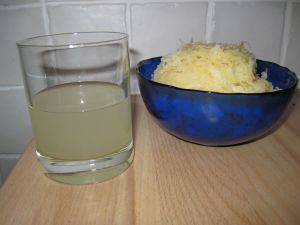No Longer Sour About Kraut
by forumholitorium
I had always cultivated a hatred of cabbage. Sure, it is a superfood packed with vitamins C and K that may prevent cancer and radiation sickness and all that, but with the exception of the red cabbage I once ate at Oktoberfest in New Glarus and small doses of white cabbage and mushroom pierogi served up to me during the time I lived in Poland, it didn’t taste good. Plus I have always associated it with a heavy meat and potatoes diet where the only vegetables are cooked until they are dead and tasteless or stinky. Ugh. It lurked at the opposite end of the spectrum of my food preferences, far away from Italian cuisine. Wrong!
In fact, cabbage has been important to cooking on the Apennine peninsula for a very long time. This unjustly maligned (by me) vegetable originated along the shores of the Mediterranean as well as of the North Sea. The Romans prized its effect on digestion and preserved it in vinegar, while in northern Europe, cabbage was turned into sauerkraut using lactic acid fermentation. This method of preparation ultimately spread from north to south through the Alps all the way to Trieste on the Adriatic, where a special bean soup with sauerkraut called jota is prepared.
So what led to a sea change in my food prejudices? A few weeks back, a friend served homemade kale chips that, well, tasted pretty good. Up until then, I had avoided kale because it is a kind of cabbage and I just assumed it wouldn’t taste good. Shortly after this trying-something-new happy ending, my partner (hereafter referred to as TC = The Chemist), expressed a wish for sauerkraut to recover from a few weeks of travel. We picked up a bag of what we thought was sauerkraut at the market. Back in our kitchen, it became apparent that what we had purchased was straggly raw green cabbage masquerading as sauerkraut. So I took matters into my own hands.

All you need to make sauerkraut is cabbage, a jar, and some salt. I started with 500 g finely sliced cabbage, an empty 1 kg honey jar, and about 1 Tbs salt. Put some cabbage in the jar, pack it down, sprinkle some salt over it, and repeat until you run out of cabbage and salt. As you pack down the cabbage, it should start to release juice which mingles with the salt to make a brine. I placed a glass filled with water whose circumference was smaller than the mouth of the jar into the jar to weigh down the cabbage and force more liquid out. This liquid layer that forms is key to the success of the endeavor because it keeps air away from the cabbage. And even though you don’t want air and cabbage to meet, don’t even think of putting the lid on the jar. Bubbles will form when fermentation is underway, and the carbon dioxide needs to escape somewhere. With time, Lactobacillus bacteria will transform the cabbage into kraut. More detailed info on lactic acid fermentation and the role of ferments in French cuisine can be found here.
Every day or so, I checked on the kraut, packing it down more not because it was necessary but because it was fun. After two weeks, we had 350 g sauerkraut and half a glass of sauerkraut juice.

Since sauerkraut juice is incredibly healthy, I felt obligated to drink at least some of it, but the smell put me off so much I couldn’t. Thankfully, TC drank it and happily set about eating his sauerkraut. Disappointed in my lack of adventure, I decided to try again, this time with red cabbage.

Once again, 500 g finely chopped red cabbage layered with 1/2 Tbs salt (less because the first kraut was quite salty) was packed firmly into the glass jar and left to ferment for roughly two weeks. This time when we tried the juice, TC said “It tastes like Bauernhof!” Farm? Well, there was something earthy and beety to the flavor, and it was not bad. Yes, I drank it! One baby step toward increasing cabbage consumption. We’ll have some for dinner tonight.


I admit, I’m not a fan of kraut or cooked cabbage. I love my cabbage raw. My favorite slaw recipe of the last couple years is a mexican inspired lime and peanut slaw: http://smittenkitchen.com/2010/04/cabbage-and-lime-salad-with-roasted-peanuts/
Happy cabbage eating!